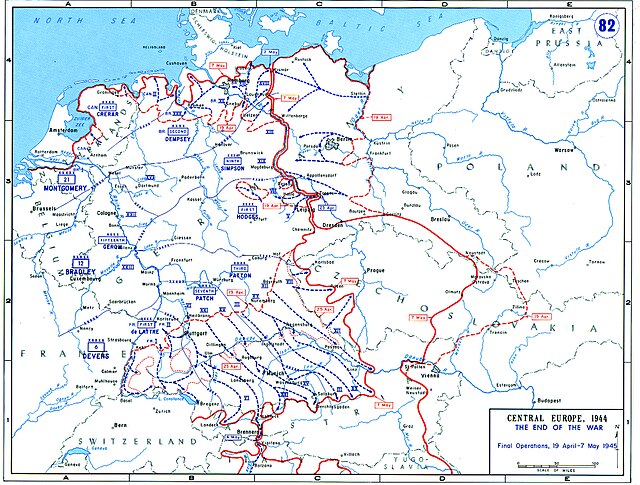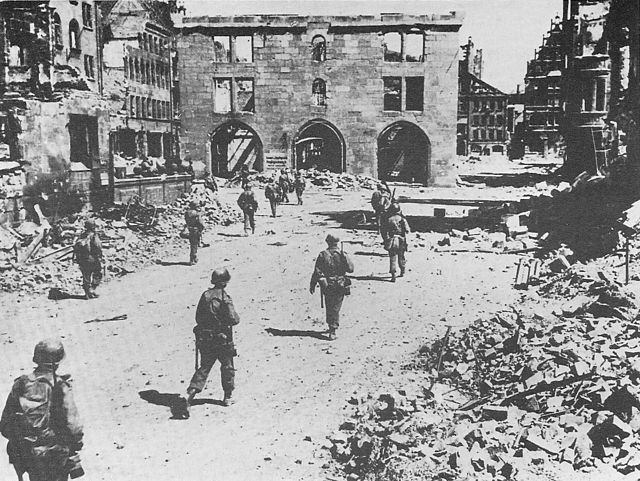中欧会战
来自维基百科,自由的百科全书
中欧会战(英语:Central Europe Campaign)是第二次世界大战盟军为在中欧地区击退德军及攻入纳粹德国本土所发动的一连串军事行动,时间是自1945年3月22日到5月11日东线苏军攻占德国首都柏林为止,盟军统称取名为“中欧会战”。
此条目需要扩充。 (2010年4月8日) |
| 中欧会战 | |||||||
|---|---|---|---|---|---|---|---|
| 第二次世界大战的一部分 | |||||||
 1945年4月期间,美军士兵在一辆M4雪曼战车的支援下冲进位于德国韦恩贝格一条满布浓烟的街道 | |||||||
| |||||||
| 参战方 | |||||||
|
|
| ||||||
| 指挥官与领导者 | |||||||
|
|
| ||||||
| 伤亡与损失 | |||||||
|
美国: 62,704人 (包含14,507人死亡或失踪)[1] 法国: 18,306人[2] (包含4,967人死亡) 英国: 17,930人[3] (包含4,878人死亡或失踪)[3] 加拿大: 6,490人 (包含1,747死亡或失踪)[4] 乌克兰第三方面军: 1,171,800人(38,661人死亡)(包含保加利亚) 其他盟军: 715人[3] (包含207人死亡或失踪) |
1945年1月-5月: | ||||||
在1945年春天欧洲战场局面转为对盟军有利,德军在突出部之役中受创。阿登攻势是德军在西线最后一次最大反攻作战,但却以失败告终并消耗德军剩余战力,残存的德军撤退至莱茵河东岸堤防防守。到3月中旬盟军推进至莱茵河,美军第1集团军成功攻占雷玛根市鲁登道夫大桥,并在此桥东岸建立小面积桥头堡。
东线方面全面反攻的苏联红军已经占领波兰大部分地区,而德军已全线崩溃,因此苏军有如潮水般拥入匈牙利及捷克东境,并攻入德国本土东面暂时抵逹“奥德河-尼斯河线”。苏军在东线的快速推进,消灭了德军不少兵力,导致防卫莱茵河区的德军明显兵力缺乏。而西方盟军已经完成了他们的准备工作,准备随时攻入德国总司令部,盟军似乎胜利在望。
战斗部队序列
盟军部队共有90个满编的师,包括25个坦克师及5个伞兵空降师。战线沿着莱茵河南北延伸450公里,北至荷兰北境北海、南至瑞士国界。
盟军沿着这条线被划分为3个集团军:在北方自荷兰北海边到德国科隆市,由英军元帅蒙哥马利统领英军第21集团军负责。其中加拿大第1军团负责盟军战线左翼 ,紧接是英军第2军团居正中,美军第9军团居战线南段。
由美军第9军团右翼至德国美因茨一段,由美军上将奥马尔·布拉德利领导的美军第12集团军负责。第12集团军辖下有美军两个军团:考特尼·霍奇斯将军美军第1军团及乔治·巴顿将军的美军第3军团。美军第1军团在战线的左翼(北方),而第3军团在战线的右翼(南边);
迎战的是当时德国西线总指挥官是阿尔贝特·凯塞林元帅。他自1945年3月10日才刚接格特·冯·伦德施泰特老元帅职缺。虽然他才从意大利防御战改调任至此,有着在意大利成功防守盟军事迹,被赞誉为“防守战略家”。但他严重缺乏所需要军事资源保卫以建立防线,例如:此时兵力缺乏的莱茵河德军防卫兵力只剩下26个师。它们分属于德军三个集团军H、B、G。德军总司令部优先集中所有兵力在东线对抗苏联红军,因而只能补拨少量的援兵到“西线”德军。
3月21日“德军H集团军”司令部改编为“德军西北司令部”(Oberbefehlshaber Nordwest)由恩斯特·布施元帅统领。约翰内斯·布拉斯科维茨的“德军H集团军”改编组为德军驻荷兰集团军。恩斯特·布施将军的主力军是德军第1空降军团则负责担任“帝国保卫战”防线的右翼。在德军防线的中央莫德尔元帅的德军B集团军(下辖:德军第15军团与第5装甲军团)以保卫鲁尔区。而保罗·豪塞尔的德国G集团军(下辖:德军第7军团、第1军团与第19军团)驻守在防线的南方。
艾森豪战略
在攻占鲁尔区同时,艾森豪计划以第21集团军向东边挺进,横越德国北部平原攻至柏林,而美军第12军团与第6军团将发动牵制性攻势,减少盟军推进的阻力。
有几个原因理由让艾森豪在3月底重新调整这些军事计划,首先他的司令部收到情报说:苏军在奥得河已经建立渡江桥头堡,距柏林只有距离30英里(48千米),而盟军自莱茵河畔到柏林还超过 300英里(480千米) ,即便更向德国内陆推进至易北河畔离柏林仍有 200英里(320千米) 远,似乎再清楚不过苏军会被比盟军更快的攻占柏林。艾森豪从而把注意力转向了其他目标,其中最重要的是美军尽快与苏军会师,以将德军截成两段。再将残存的德军各个击破[7]。
另外“鲁尔工业区”仍旧聚集大批德军防守。而且工业区是德国作战动力所在,因此盟军将其列为第一攻占目标谋略不变。此时盟军情报单位发现:鲁尔地区许多军事武器制造重工业已经在迅速悄悄拆卸移转至德国南部更内陆地区,这增加了发动横跨莱茵河南部攻势的重要性[7]。
但也许调整军事计划更多是基于美国人,当英军蒙哥马利元帅小心翼翼地谋略在北德发动大规模推进德国本土攻势,打算动员大规模空军和空降兵协同,相对而言南方美军展示出简单的进取是艾森豪更想看到的。
3月7日考特尼·霍奇斯中将率领美军第1集团军攻占雷玛根市鲁登道夫大桥横越莱茵河并很快建立桥头堡。 南德萨尔普法尔茨(Saarpfalz-Kreis)地区,美军乔治·巴顿中将率领美军第3军团给乎德军第7军团毁灭性的打击,并联合美军第7军几近消灭德军第1军团。在5天战斗时程内,3月18至22日巴顿军虏获超过68,000名德军。这些大胆的行动,瓦解莱茵河西岸所有德军阵地。
尽管蒙哥马利仍在谋略渡河后大举攻德,艾森豪认为不应把美军的势头浪费,仅发动有限的牵制性攻势。在3月底艾森豪因此决定让美军担当更重要的角色,攻德战役的最先几天已经足以令艾森豪确信这是正确的。
军事行动
3月19日艾森豪告诉布莱德雷准备第1军团于3月22日以后随时自“雷玛根大桥”突破。同日为响应第3军团的强劲表现在萨尔—普法尔茨地区,并且令莱茵河东岸能部置一支守护第1军团侧翼的强大的部队,布拉德利给予巴顿的不须顾忌尽快越过莱茵河的许可。
这些进攻命令正投巴顿所好,美国人一般认为,如果一个足够强大的美军部队冲过莱茵河并打出大胜仗,艾森豪就有足够理由把夺占德国的主力作战,自英军蒙哥马利英军第21集团军那里转移给布莱德雷美军第12集团军。巴顿也感谢这个机会,他现在计划比蒙哥马利更快过河,以为第3军团赢得了在现代历史上第一个越过莱茵河过路的荣誉,为了要做到这一点,他必须快速行动。
21日巴顿命令属下美军第12军在22日凌晨渡过莱茵河,比蒙哥马利排订渡河时间早一日。巴顿马上调集在从去年秋天美军开始囤积在洛林仓库里所有攻击艇,迫不及待想提早渡河。
3月22日深夜美国第3军团开始度河,第5步兵师的第11步兵团最先在尼尔斯泰因过河,德军只是零星的抵抗[8]。到了3月23日下午第5步兵师全师以及第90步兵师的1个团到达了桥头堡。到了午夜步兵部队已经推进至超过8公里的边界内陆,3月25日清晨美军第8军的两个师也越过了莱茵河。
美国第6军团在3月26日开始度河,第7军团的第15军在美因茨以南约40公里的沃尔姆斯展开了攻击。
掠夺行动(Operation Plunder)于3月23日晚至24日黎明展开,盟军轰炸机及炮兵展开了极为猛烈的轰炸。随后英军第51高地师、第15苏格兰师、英军第1突击旅及美军第30和79步兵师展开渡河,并建立5个桥头堡。
大学校队行动(Operation Varsity)于3月24日清晨开始由英军第6空降师和美军第17空降师组成的第18空降军负责。伞兵于韦塞尔北部展开空降以抵挡德军对桥头堡的反击,最终第21集团军成功在里斯与韦塞尔一带建立稳固的桥头堡。
艾森豪威尔调整了盟军的进攻计划,尽管受到丘吉尔的抗议,艾森豪将柏林由盟军进攻目标上清除,把柏林留给苏军,第12集团军将成为先头部队向易北河并与苏军会师。
美军第9集团军改往东南推进与美军第1集团军夹击德国B集团军,在1945年4月1日两个集团军在接近利普斯塔特的地方会师。4月4日的包围圈完成,第9军重回第12集团军指挥,德国B集团军受困于鲁尔口袋内,最终德军B集团军共320,000人向美军投降,而莫德尔元帅也于不久后自杀。
4月25日美国第1集团军于穆尔德河和苏军进行第一次会师,在托尔高附近美国第69步兵师的巡逻部队与苏联第5近卫集团军最先进行了接触。两军会师意味着德军被截成南北两段,盟军的东、西两条战线从此联接,欧战的胜利将近,成为世界反法西斯战争的欧洲战场出现胜利的曙光,也是希特勒的纳粹政权即将覆亡的象征之ㄧ,后来4月25日被记念为易北河日。


在美国第12集团军右方,美国第6集团军向德国南部阿尔卑斯地区和奥地利西部推进。亚历山大·帕奇中将指挥的第7集团军于3月28向南推进,德国G集团军尝试作出抵抗,于海布隆的美国第6军遇到较激烈的抵抗,经9日激战后于4月12日才攻克了该市。其后在5日的激战后美军于4月20日又攻克了纽伦堡。而美国第21军相继攻下了施韦因富特及奥格斯堡,美国第15军则于4月30日攻占了慕尼黑。
随后美国第6军与法军第1集团军在4月22日越过多瑙河攻入奥地利。而在美国第7集团军左面巴顿所率领的美国第3集团军也于4月24渡河。美国第21军及美国第15军则于5月3日渡河。当盟军进入奥地利时,许多城镇立刻举起白旗投降。5月4日美国第3集团军最终到达了捷克斯洛伐克边界,而美国第6军也与意大利战区的美军会师,至此美军停止了进攻,德国G集团军也于5月初投降。
正当美军向南部阿尔卑斯山推进,第21集团军开住东北部和北部地区。英国第2军团的右翼于4月19日到达了汉堡。在遭到德军第1空降军激烈的抵抗后,终于在5月2日攻克了汉堡,而其左翼则于4月27日攻占了不莱梅。
5月8日德国投降,宣告了第二次世界大战欧洲战场的结束。
参考注释
外部链接
Wikiwand - on
Seamless Wikipedia browsing. On steroids.
